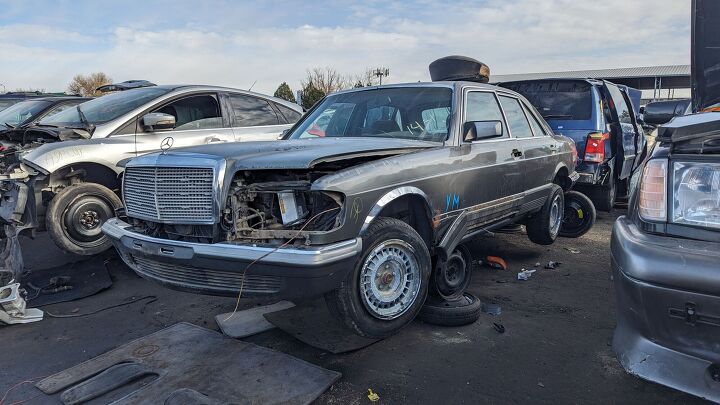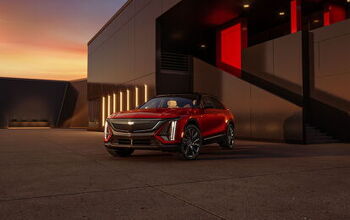Junkyard Find: Gray-Market 1981 Mercedes-Benz 380 SEL

Of all the European-market new cars that flooded into the United States during the wild gray-market years of the early and middle 1980s, the Mercedes-Benz W126 S-Class appears to have been the most popular. Today's Junkyard Find is one of those cars, found in a self-service boneyard near Denver, Colorado.
I'd found several discarded gray-market W126s in Colorado car graveyards before spotting this one, including a 1980 280 SEL, a 1980 500 SE and a 1983 500 SEC. I've also found (what was almost certainly) a gray-market W108 proto-S-Class.
The easiest way to spot a gray-market W126 is to look for a cloth interior; U.S.-market cars got leather or MB-Tex inside.
European-market W126s have different headlights and bumpers, too, but the headlights usually get grabbed by the first junkyard shopper to recognize them.
When you brought a gray-market W126 (or R107) over, you got all the good Euro-market powertrain, appearance and interior stuff and you saved money versus the MSRP of that car's counterpart in an American Mercedes-Benz dealership. It wasn't for the faint of heart, but it could be done if you kept your wits about you.
By 1986, 60,000 gray-market cars a year were coming into the United States, the majority of them Stuttgart products, and the heads of Mercedes-Benz dealers here were exploding like a graphite-moderated/water-cooled Soviet nuclear reactor did that year.
After years of intensive Mercedes-Benz-backed lobbying, H.R.2628 aka the Imported Vehicle Safety Compliance Act of 1988 was passed by the 100th Congress. After that, imported cars had to be brought into strict compliance with the smallest fine print of federal vehicle standards, something almost no shops could handle. The gray-market party was over.
For the 1981 model year, the U.S.-market 380 SEL came with a 3.8-liter SOHC V8 rated at 155 horsepower and 196 pound-feet, which was pretty good on this side of the Atlantic at that time. The price tag on that car was $44,298, or about $157,037 in 2024 dollars.
Meanwhile, the version of this engine sold in West Germany made 215 horsepower and 169 pound-feet. The real gray-market cowboys bought the even more powerful 500 SEL, which wasn't even available here until the 1984 model year.
1981 was the first model year for an optional driver's-side airbag in the W126. This car has one.
It also has some kind of aftermarket radio-frequency device, maybe for one of the clunky car telephones of the era.
There's no depreciation like European luxury car depreciation.
The gauge cluster was gone when I arrived, but a VIN search shows that it was auctioned off with 96,807 miles (or perhaps that was kilometers, though most gray-market W126s ended up getting non-metric gauge conversions).
This West German dealership promo video is for the W126 coupe, but you get the idea.
The W126 was sold in the United States through 1991, after which it was replaced by the flashier but flakier W140.
1981 Mercedes-Benz W126 in Colorado wrecking yard.
1981 Mercedes-Benz W126 in Colorado wrecking yard.
1981 Mercedes-Benz W126 in Colorado wrecking yard.
1981 Mercedes-Benz W126 in Colorado wrecking yard.
1981 Mercedes-Benz W126 in Colorado wrecking yard.
1981 Mercedes-Benz W126 in Colorado wrecking yard.
1981 Mercedes-Benz W126 in Colorado wrecking yard.
1981 Mercedes-Benz W126 in Colorado wrecking yard.
1981 Mercedes-Benz W126 in Colorado wrecking yard.
[Images: Author]
Become a TTAC insider. Get the latest news, features, TTAC takes, and everything else that gets to the truth about cars first by subscribing to our newsletter.

Murilee Martin is the pen name of Phil Greden, a writer who has lived in Minnesota, California, Georgia and (now) Colorado. He has toiled at copywriting, technical writing, junkmail writing, fiction writing and now automotive writing. He has owned many terrible vehicles and some good ones. He spends a great deal of time in self-service junkyards. These days, he writes for publications including Autoweek, Autoblog, Hagerty, The Truth About Cars and Capital One.
More by Murilee Martin
Latest Car Reviews
Read moreLatest Product Reviews
Read moreRecent Comments
- Varezhka I have still yet to see a Malibu on the road that didn't have a rental sticker. So yeah, GM probably lost money on every one they sold but kept it to boost their CAFE numbers.I'm personally happy that I no longer have to dread being "upgraded" to a Maxima or a Malibu anymore. And thankfully Altima is also on its way out.
- Tassos Under incompetent, affirmative action hire Mary Barra, GM has been shooting itself in the foot on a daily basis.Whether the Malibu cancellation has been one of these shootings is NOT obvious at all.GM should be run as a PROFITABLE BUSINESS and NOT as an outfit that satisfies everybody and his mother in law's pet preferences.IF the Malibu was UNPROFITABLE, it SHOULD be canceled.More generally, if its SEGMENT is Unprofitable, and HALF the makers cancel their midsize sedans, not only will it lead to the SURVIVAL OF THE FITTEST ones, but the survivors will obviously be more profitable if the LOSERS were kept being produced and the SMALL PIE of midsize sedans would yield slim pickings for every participant.SO NO, I APPROVE of the demise of the unprofitable Malibu, and hope Nissan does the same to the Altima, Hyundai with the SOnata, Mazda with the Mazda 6, and as many others as it takes to make the REMAINING players, like the Excellent, sporty Accord and the Bulletproof Reliable, cheap to maintain CAMRY, more profitable and affordable.
- GregLocock Car companies can only really sell cars that people who are new car buyers will pay a profitable price for. As it turns out fewer and fewer new car buyers want sedans. Large sedans can be nice to drive, certainly, but the number of new car buyers (the only ones that matter in this discussion) are prepared to sacrifice steering and handling for more obvious things like passenger and cargo space, or even some attempt at off roading. We know US new car buyers don't really care about handling because they fell for FWD in large cars.
- Slavuta Why is everybody sweating? Like sedans? - go buy one. Better - 2. Let CRV/RAV rust on the dealer lot. I have 3 sedans on the driveway. My neighbor - 2. Neighbors on each of our other side - 8 SUVs.
- Theflyersfan With sedans, especially, I wonder how many of those sales are to rental fleets. With the exception of the Civic and Accord, there are still rows of sedans mixed in with the RAV4s at every airport rental lot. I doubt the breakdown in sales is publicly published, so who knows... GM isn't out of the sedan business - Cadillac exists and I can't believe I'm typing this but they are actually decent - and I think they are making a huge mistake, especially if there's an extended oil price hike (cough...Iran...cough) and people want smaller and hybrids. But if one is only tied to the quarterly shareholder reports and not trends and the big picture, bad decisions like this get made.






















































Comments
Join the conversation
So many grey market cars around in the mid ‘80s. This one was on the leading edge of the wave.
I’ll take mine as a manual E23 733i, thanks.
I just read up a bit more on the early-1980s gray-market game and found that the mysterious beige plastic electronics case I shot is actually a "Johnson Box," which was a device made to put the K-Jetronic system into enough of a closed loop to pass 1981 U.S. emissions requirements. It appears that there was a whole industry of little shops making Johnson Boxes in Southern California at that time.